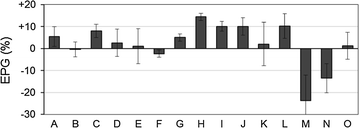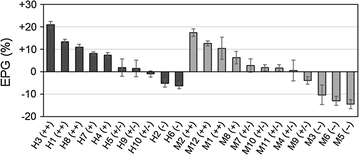Evaluation of environmental bacterial communities as a factor affecting the growth of duckweed Lemna minor
- PMID: 28293292
- PMCID: PMC5345205
- DOI: 10.1186/s13068-017-0746-8
Evaluation of environmental bacterial communities as a factor affecting the growth of duckweed Lemna minor
Abstract
Background: Duckweed (family Lemnaceae) has recently been recognized as an ideal biomass feedstock for biofuel production due to its rapid growth and high starch content, which inspired interest in improving their productivity. Since microbes that co-exist with plants are known to have significant effects on their growth according to the previous studies for terrestrial plants, this study has attempted to understand the plant-microbial interactions of a duckweed, Lemna minor, focusing on the growth promotion/inhibition effects so as to assess the possibility of accelerated duckweed production by modifying co-existing bacterial community.
Results: Co-cultivation of aseptic L. minor and bacterial communities collected from various aquatic environments resulted in changes in duckweed growth ranging from -24 to +14% compared to aseptic control. A number of bacterial strains were isolated from both growth-promoting and growth-inhibitory communities, and examined for their co-existing effects on duckweed growth. Irrespective of the source, each strain showed promotive, inhibitory, or neutral effects when individually co-cultured with L. minor. To further analyze the interactions among these bacterial strains in a community, binary combinations of promotive and inhibitory strains were co-cultured with aseptic L. minor, resulting in that combinations of promotive-promotive or inhibitory-inhibitory strains generally showed effects similar to those of individual strains. However, combinations of promotive-inhibitory strains tended to show inhibitory effects while only Aquitalea magnusonii H3 exerted its plant growth-promoting effect in all combinations tested.
Conclusion: Significant change in biomass production was observed when duckweed was co-cultivated with environmental bacterial communities. Promotive, neutral, and inhibitory bacteria in the community would synergistically determine the effects. The results indicate the possibility of improving duckweed biomass production via regulation of co-existing bacterial communities.
Keywords: Biomass production; Duckweed; Plant growth-inhibiting bacteria; Plant growth-promoting bacteria.
Figures



References
-
- Landolt E. Biosystematic investigations in the family of duckweed (Lemnaceae) Stiftung Rubel, Zúrich: Geobotanischen Inst ETH; 1986.
-
- Cheng JJ, Stomp AM. Growing duckweed to recover nutrients from wastewaters and for production of fuel ethanol and animal feed. Clean. 2009;37:17–26.
-
- Ahmad Z, Hossain NS, Hussain SG, Khan AH. Effect of duckweed (Lemna minor) as complement to fertilizer nitrogen on the growth and yield of rice. Int J Trop Agric. 1990;8:72–79.
-
- Lahive E, O’Halloran J, Jansen MAK. Differential sensitivity of four Lemnaceae species to zinc sulphate. Environ Exp Bot. 2011;71:25–33. doi: 10.1016/j.envexpbot.2010.10.014. - DOI
LinkOut - more resources
Full Text Sources
Other Literature Sources
Molecular Biology Databases

